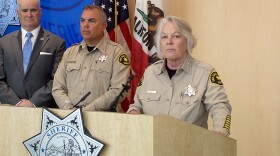Last night I saw not just the best play at San Diego Fringe 2014 but also one of the best theater experiences I’ve ever had in my life at Tin Shed Theatre Company’s “Dr. Frankenstein’s Travelling Freakshow.”
The flyers for the show suggest, “Mary Shelley will roll in her grave...” But truth be told, she would more likely rise up in joy because this show, despite its silly trappings, goes to the heart of what she wrote about in her book. They just tackle the themes with far less pretension and far more innovation than most other adaptations.
Whether in San Diego or in the originating city of Edinburgh, Fringe is — at its best — all about bold creativity and taking risks. San Diego Fringe has served up shows that are fun, hilarious, poignant, kinetic, absurd, charming and clever. And no offense to the talented folks presenting these work, but Tin Shed Theatre and its “Dr. Frankenstein” show are simply in a league of their own. What’s so breathtakingly impressive is how they manage to do so much and make it seem so easy. They combine low comedy and high art; broad physical comedy and subtle emotional shadings. They create a world and invite us in and leave us amazed.
'Dr. Frankenstein's Travelling Freakshow'
San Diego Fringe Final Performance
Wednesday, July 9, 5 p.m.
Spreckels Theatre Fringe Off Broadway, 923 First Ave.
The quartet of performers in Tin Shed do what theater at its best should do — pull you to the edge of your seat, and make you crane your neck to see over or between audience members in front of you because you do not want to miss a single detail. They make you laugh uncontrollably, squirm uncomfortably, and ultimately move you with genuine pathos. One of the reasons the play is so spellbinding is that it works with so little — three boxes, a tent, four actors and an empty stage. Oh and an excess of mad skillz.
The show opens with Julius M. Barker (Justin Edward Cliffe’s sideshow Vincent Price) welcoming us to his Freakshow. He begins by introducing us to his “freaks:" Bethilda, The Bearded Lady (Georgina Ella Harris) and Sangieve, The Lobster Mind Reader (Antonio Alfonso Rimola). Of course everything goes horribly wrong and Barker is forced to make apologies, which of course means “consequences” for the freaks. Then he brings out the main attraction, Dr. Frankenstein’s monster (Aled Wyn Thomas) and forces the poor creature to recount his pitiful tale.
The program describes Tin Shed’s approach as influenced by “Meta-Theatre, German Expressionism, Brechtian techniques and the French Clowning tradition,” and utilizing “puppetry, mixed media and a high-energy performance style.” Although this sounds like a mishmash of disparate elements, the brilliance of the show is how seamlessly and fluidly it all comes together. They truly transport you to another dimension, and you forget the real world just outside the door and willing embrace the strange world they create from practically nothing.
In addition, what’s so unexpected is that despite the Victorian sideshow setting and broad pantomime/clowning, “Dr. Frankenstein’s Travelling Freakshow” captures the true essence of Shelley’s novel. It is about what defines us as human and explores our basic need for love and companionship. It shows us both beauty and horror, and does so with both mocking humor and genuine compassion. Barker's callous cruelty and arrogant sense of ownership over other people, can be used for comic effect but it also makes us think about the metaphor of the Freakshow and who the real freaks are.
The performers bound about the stage with a seemingly endless supply of energy and ferocious dedication. They perform from a script but have the quicksilver ability to adapt to circumstance without breaking character as when someone’s cell phone repeatedly went off during last night’s performance. Although not a puppet show, there are multiple puppetry sequences that are spellbinding. First is a hilarious one involving Bethilda and a scholarly puppet. Then there are projected shadow puppets depicting Dr. Frankestein’s creation of the monster that completely catch you up in its tale within a tale. And finally, a faceless, white fabric puppet (operated by Harris and Rimola) of the monster that comes to poignant life. What’s impressive about this last one is that at certain points, the operators draw attention to themselves and yet never break the illusion they are creating. Rimola holds one of the dowels to operate the puppet in his mouth and turns it into a gag that gets laughs. By all means this should pull us out of the magic but it doesn’t. And that’s one of the things that these performers do so well — they make us aware of the artifice of a stage performance (pointing out things that go wrong, apologizing for the cheapness of their show, and more) and yet somehow manage to make that draw us in even deeper into the world they are creating. I find that words are ineffective in describing this theatrical miracle, you will simply have to come see them to understand the spell they cast.
It’s a shame that Wednesday will be their last performance and that in total they had only a handful of shows that could only be seen by a couple hundred people. All I can say is thank you to Tin Shed for making the trek to America and to San Diego Fringe for showcasing them. I can only hope they will be back. It’s not often I can sit in awe for an hour and leave a theater filled with such wonder and delight that I don’t want to see anything else, I just want to savor the experience for as long as I can.






